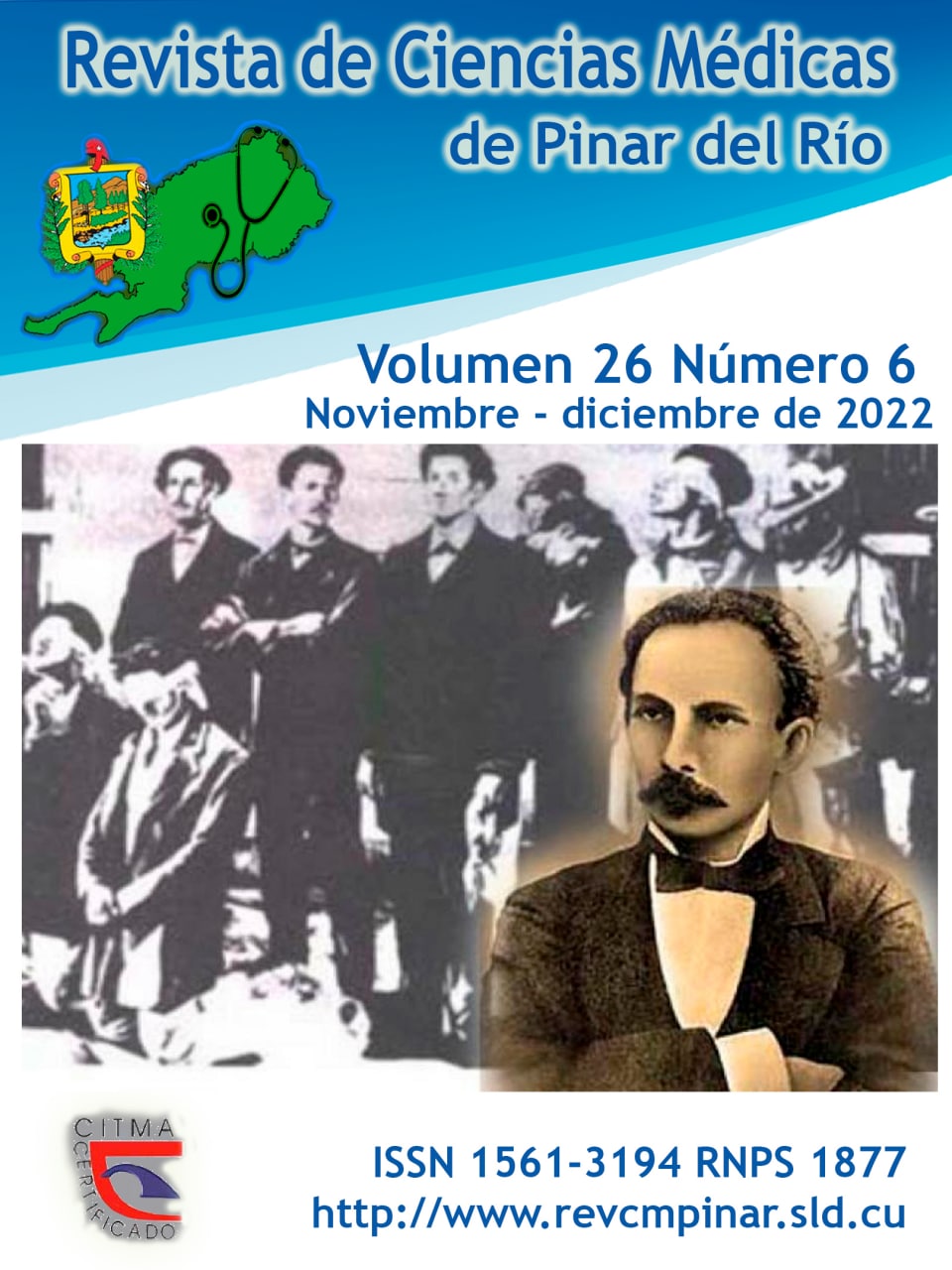Characterization of patients with pituitary tumors attended at the "Hermanos Ameijeiras" Hospital between 2017 and 2019
Keywords:
PITUITARY NEOPLASMS, NERVOUS SYSTEM NEOPLASMS, ACTH-SECRETING PITUITARY ADENOMA, ROWTH HORMONE-SECRETING PITUITARY ADENOMA, PROLACTINOMA.Abstract
Introduction: the term pituitary tumor groups a series of miscellaneous diseases and corresponds to primary tumor lesions of the pituitary parenchyma.
Objective: to characterize patients with pituitary tumors seen at the "Hermanos Ameijeiras" Clinical Surgical Hospital between 2017 and 2019.
Methods: observational, descriptive, longitudinal and prospective study of patients with a diagnosis of pituitary tumors seen in the outpatient clinic of Pituitary Diseases and the Endocrinology Service of the Clinical Surgical Hospital "Hermanos Ameijeiras" between 2017 and 2019. The sample consisted of 267 patients. The individual medical records of the patients were used for data collection. Descriptive statistics were used.
Results: female sex predominated (79,03 %) and patients with non-functioning pituitary tumor (59,93 %), followed by those with prolactin-secreting tumors (31,46 %). Only in one patient with non-functioning pituitary tumor the finding was incidental. The most common symptom expressed by the patients was headache (85,77 %). In each functioning tumor an excess production of the specific hormone was determined. A predominance of patients with microadenomas was found (70,79 %).
Conclusions: Pituitary tumors were common in female patients, with predominance of the non-functioning type and microadenomas. Although the diagnosis may be incidental, many patients present with mass effect symptoms such as headache. Patients present with increased tumor-specific hormones.
Downloads
References
1. Würth R, Thellung S, Corsaro A, Barbieri F, Florio T. Experimental Evidence and Clinical Implications of Pituitary Adenoma Stem Cells. Front Endocrinol (Lausanne) [Internet]. 2020 [citado 12/01/2022]; 20(11):54. Disponible en: https://pubmed.ncbi.nlm.nih.gov/32153500/
2. Anahi Cecenarro L, Moyano Crespo GD, Mukdsi JH. Actualización sobre mecanismos de tumorogénesis hipofisiaria. Revista de la Facultad de Ciencias Médicas de Córdoba [Internet]. 2021 [citado 12/01/2022]; 78(4):423-429. Disponible en: http://dx.doi.org/10.31053/1853.0605.v78.n4.29189
3. Zatelli MC. Pathogenesis of non-functioning pituitary adenomas. Pituitary [Internet]. 2018 [citado 12/01/2022]; 21(2):130-137. Disponible en: https://www.doi.org/10.1007/s11102-018-0874-6
4. International Agency for Research on Cancer (2017) WHO Classification of Tumours of Endocrine Organs, 4th ed. Medicine https://publications.iarc.fr/Book-And-Report-Series/Who-Classification-Of-Tumours/WHO-Classification-Of-Tumours-Of-Endocrine-Organs-2017
5. Drummond J, Roncaroli F, Grossman AB, Korbonits M. Clinical and pathological aspects of silent pituitary adenomas. J Clin Endocrinol Metab [Internet]. 2019 [citado 12/01/2022]; 104:2473-89. Disponible en: http://dx.doi.org/10.1210/jc.2018-00688
6. Almeida JP, Stephens CC, Eschbacher JM, Felicella MM, Yuen KCJ, White WL, et al. Clinical, pathologic, and imaging characteristics of pituitary null cell adenomas as defined according to the 2017 World Health Organization criteria: A case series from two pituitary centers. Pituitary [Internet]. 2019 [citado 12/01/2022]; 22(5):514-9. Disponible en: https://link.springer.com/article/10.1007/s11102-019-00981-9
7. López Ruíz J, Dayoub Mejías LM, Troncone MG. Caracterización de pacientes con tumores hipofisarios en la consulta del servicio de endocrinología del Hospital Vargas de Caracas, Venezuela. Revista Venezolana de Endocrinología y Metabolismo [Internet]. 2021 [citado 12/01/2022]; 19(3):138-148. Disponible en: https://www.redalyc.org/articulo.oa?id=375569375003
8. Picó A, Aranda-López I, Sesmilo G, Toldos-González Ó, Japón MA, Luque RM, et al. Recommendations on the pathological report of pituitary tumors. A consensus of experts of the Spanish Society of Endocrinology and Nutrition and the Spanish Society of Pathology. Endocrinol Diabetes Nutr [Internet]. 2021 [citado 12/01/2022]; 68(3):196-207, Disponible en: http://dx.doi.org/10.1016/j.endinu.2020.10.004
9. Fajardo-Montañana C, Villar R, Gómez-Ansón B, Brea B, Mosqueira AJ, Molla E, et al. Recomendaciones sobre el diagnóstico y seguimiento radiológico de los tumores neuroendocrinos hipofisarios. Endocrinol, Diabetes Nutr [Internet]. 2022 [citado 12/01/2022]; 69(9): 744-761. Disponible en: https://doi.org/10.1016/j.endinu.2021.10.005
10. Barahona Ulloa WF, García Iñigueza JD, Jiménez Encaladab MG, Sacoto Molina AM. Adenomas hipofisarios: características sociodemográficas, clínicas y terapéuticas de 250 casos. Neurología Argentina [Internet]. 2021 [citado 12/02/2022] 13(4):205-211. Disponible en: https://www.sciencedirect.com/science/article/abs/pii/S185300282100029X
11. Garavaglia FI, Paoletti O, Herrera E, Pueyrredon F, Montevideo A, Cabanillas J, Viano JC. Resultados y complicaciones en resección de tumores de hipófisis por endoscopia via nasal transesfenoidal. REV ARGENT NEUROC [Internet]. 2021 [citado 12/01/2022]; 35(4):277-286. Disponible en: https://ranc.com.ar/index.php/revista/article/view/109
12. Garay H, Rojas G, Alaba W, Flores J, Rodríguez R, Salcedo I. Tratamiento quirúrgico endoscópico transesfenoidal de tumores de hipófisis en el Hospital Nacional Cayetano Heredia en Lima Perú: Resultados de una serie de casos. Peru J Neurosurg [Internet]. 2020 [citado 12/01/2022]; 2(4): 109-116. Disponible en: https://perujournalneurosurgery.org/es/abss/203
13. Irigaray Echarri A, Ollero García-Agulló MD, Iriarte Beroiz A, García Mouriz M, Zazpe Cenoz I, Laguna Muro S, et al. Evaluación de protocolo de manejo periquirúrgico con glucocorticoides tras cirugía hipofisaria. Endocrinol Diabetes Nutr [Internet]. 2022 [citado 12/01/2022]; 69(5):338-344. Disponible en: https://doi.org/10.1016/j.endinu.2021.06.006
14. Shlomo M, Dan L, Longo MD. Pituitary-tumor endocrinopathies. N Engl J Med [Internet]. 2020 [citado 12/01/2022]; 382(10): 937-950. Disponible en: https://pubmed.ncbi.nlm.nih.gov/32130815/
15. Fuentes-Fayos AC, García-Martínez A, Herrera-Martínez AD, Jiménez-Vacas JM, Vázquez-Borrego MC, Castaño JP, et al. Molecular determinants of the response to medical treatment of growth hormone secreting pituitary neuroendocrine tumors. Minerva Endocrinol [Internet]. 2019 [citado 12/01/2022]; 44(2):109-28. Disponible en: https://pubmed.ncbi.nlm.nih.gov/30650942/ .
Downloads
Published
How to Cite
Issue
Section
License
Authors who have publications with this journal agree to the following terms: Authors will retain their copyrights and grant the journal the right of first publication of their work, which will be publication of their work, which will be simultaneously subject to the Creative Commons Attribution License (CC-BY-NC 4.0) that allows third parties to share the work as long as its author and first publication in this journal are indicated.
Authors may adopt other non-exclusive license agreements for distribution of the published version of the work (e.g.: deposit it in an institutional telematic archive or publish it in a volume). Likewise, and according to the recommendations of the Medical Sciences Editorial (ECIMED), authors must declare in each article their contribution according to the CRediT taxonomy (contributor roles). This taxonomy includes 14 roles, which can be used to represent the tasks typically performed by contributors in scientific academic production. It should be consulted in monograph) whenever initial publication in this journal is indicated. Authors are allowed and encouraged to disseminate their work through the Internet (e.g., in institutional telematic archives or on their web page) before and during the submission process, which may produce interesting exchanges and increase citations of the published work. (See The effect of open access). https://casrai.org/credit/



